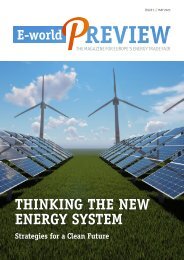E-world Magazin 01/20
Sie wollen auch ein ePaper? Erhöhen Sie die Reichweite Ihrer Titel.
YUMPU macht aus Druck-PDFs automatisch weboptimierte ePaper, die Google liebt.
14 | Wasserstoff Wasserstoff | 15
Im ersten Quartal 2020 ist der Start der Untersuchung
der Gasanwendungstechnik geplant. Dafür werden
alle bei den Kunden verbaute Gasgeräte betriebs- und
sicherheitstechnisch überprüft. Zusätzlich werden alle
Bauteile im Netzabschnitt inklusive der gesamten Installation
beim Kunden aufgenommen und in Abstimmung
mit den Geräteherstellern auf Wasserstoffverträglichkeit
geprüft. Parallel dazu laufen die technischen Planungen
für die Wasserstoffeinspeisung. Die Testphase soll nach
jetzigem Planungsstand Ende 2020 beginnen.
KONTAKT / CONTACT
www.avacon.de
info@avacon.de
„
Mit unserer langjährigen
Expertise
sowohl im Strom- als
auch im Gassektor
und der vorhandenen
Infrastruktur wollen
wir zum Wegbereiter
der P2G-Technologie
werden. Dafür engagieren
wir uns in zahlreichen
Klimaschutzprojekten.“
Marten Bunneman
Avacon CEO
Green hydrogen is indispensable on the
road to climate-neutral energy supply
Avacon plans pilot project for the first time up to
20 percent hydrogen in the German gas network
The Federal Government's ambitious climate protection targets under the Paris Climate
Protection Agreement further intensify current megatrends such as decarbonisation,
decentralisation and digitisation. The expansion of renewable energy systems,
digitisation into intelligent networks and increasing sector coupling are leading to
a fundamentally changed, increasingly decentralised and volatile energy system.
The gas infrastructure and power-to-gas (P2G) will
make it possible in future to store and transport
renewable energy and make it usable across sectors.
For example, P2G can be used to convert electricity
from wind and solar power plants into "green" gas
(hydrogen and synthetic methane) and then feed
it into existing gas grids. From there, the "green"
gas can then be used for climate-neutral gas supply
and thus for the direct decarbonisation of the heat,
transport and industrial sectors.
With many years of expertise in both the electricity
and gas sectors and the existing infrastructure, Avacon
aims to become a pioneer of P2G technology. However,
if the common climate targets are to be achieved and
innovations are to be driven forward, fossil fuels must
be involved in climate change on the cost side.
The energy service provider is currently involved in
numerous projects and studies. For example, Avacon
is a partner in the "Windwasserstoff für Stahlwerk
Salzgitter" project, a groundbreaking energy project
that is being developed together with Salzgitter
Flachstahl and Linde. The aim of the project is to generate
hydrogen from wind power by electrolysis. This
is intended to create an important basis for the future
use of larger quantities of hydrogen to reduce direct
CO 2 emissions in steel production. The project is an important
step towards a hydrogen-based industry.
Avacon and EEW Energy from Waste are also planning
another project at the traditional energy site in the
Helmstedt area. The two partners want to establish an
innovative centre for sustainable "green" hydrogen
production there. In an initial project outline, they
have shown possibilities for effectively using the existing
green electricity resources from the existing wind
power capacities in the neighbouring Magdeburger
Börde and the EEW's existing thermal waste utilisation
plant for the production of green hydrogen. These
can be produced by using the carbon dioxide to be
separated from the flue gases of the existing EEW waste
recycling plant. Given the existing infrastructure, such
a project would be scalable to a final capacity of at least
100 megawatts of electrolysis capacity.
Making the gas network hydrogen-compatible
Avacon is planning an unprecedented project in a
gas distribution network in Germany in a subnet
in Saxony-Anhalt: here the energy company wants
to add up to 20 percent by volume of hydrogen to
natural gas for the first time. The joint project with
the German Gas and Water Association (DVGW) is
intended to show that it is feasible to feed hydrogen
into an existing gas network at a significantly higher
© E.ON SE
„
percentage rate than currently provided for in the
regulations. The results of the joint project should
serve as a model for the future use of hydrogen in
gas distribution networks. Laboratory tests show
that many different devices can be operated with up
to 30 percent hydrogen admixture. All devices will
be tested with 23 percent hydrogen as part of the
approval process. The challenge now lies in practice:
Can all installed
gas appliances be
operated reliably with
With our many years
of expertise in both
the electricity and
gas sectors and the
existing infrastructure,
we want to pave
the way for P2G technology.
We are committed
to this goal
in numerous climate
protection projects."
this fuel gas mixture
over a longer period
of time even under
practical conditions?
No experience has
been gained to date in
this respect, as there
is currently no gas
network operated with
an admixture of 20
percent by volume of
hydrogen.
For the pilot project,
which is part of E.ON's
"Green Gas from Green
Power" initiative, a
section of the Avacon
gas distribution
network in Jerichower
Land in Saxony-Anhalt was selected. It is particularly
suitable for the project because the network
infrastructure installed there is representative of
the entire Avacon gas distribution network and
the results are therefore transferable. The network
section is a medium-pressure distribution network
with a pipeline length of around 35 kilometers, from
which around 350 network customers are supplied
with natural gas.
Marten Bunneman
Avacon CEO
The investigation of gas application technology is
scheduled to start in the first quarter of 2020. To this
end, all gas appliances installed at customers' sites
will be inspected from an operational and safety
point of view. In addition, all components in the
network section, including the entire installation
at the customer's site, will be inspected and tested
for hydrogen compatibility in consultation with the
appliance manufacturers. At the same time, the
technical planning for the hydrogen feed-in is in
progress. According to current planning, the test
phase is to begin at the end of 2020.

















